Salad Greens All Winter With Solar Heat
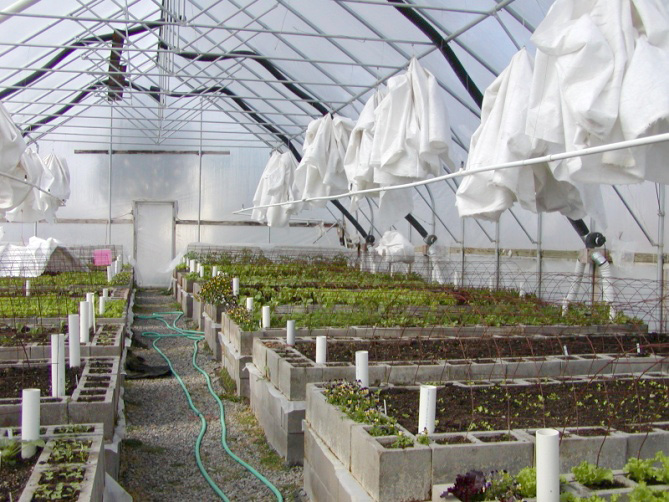 Back in 2004 we applied for a grant from CSU Specialty Crops Program to test one of our ideas of growing salad greens in the winter without a propane heater. We were awarded the grant and got right to our project. It is now 10 years later and the system has proven itself to work great every year. I have received so many requests to learn how to do this growing system that I have rewritten the grant report and results for you to have. This system is great because it is modular and a person could use it for growing for one family or on a commercial scale. We use it on a commercial scale and have 18 grow beds set up this way.
Back in 2004 we applied for a grant from CSU Specialty Crops Program to test one of our ideas of growing salad greens in the winter without a propane heater. We were awarded the grant and got right to our project. It is now 10 years later and the system has proven itself to work great every year. I have received so many requests to learn how to do this growing system that I have rewritten the grant report and results for you to have. This system is great because it is modular and a person could use it for growing for one family or on a commercial scale. We use it on a commercial scale and have 18 grow beds set up this way.
The objective of this project was to grow in a greenhouse specialty organic greens in solar-modular grow beds heated by the sun instead of fossil fuels. The project took place between October 2004 and March 2007. The test ran for 22 weeks on the back side of the calendar. We didn’t include any results from April through September. Records were kept on the greens grown and harvested. A tally of the total greens produced and sold were totaled and compared to the costs of solar heat and propane heat (estimated from records of other greenhouses on the property).
Materials and Methods:
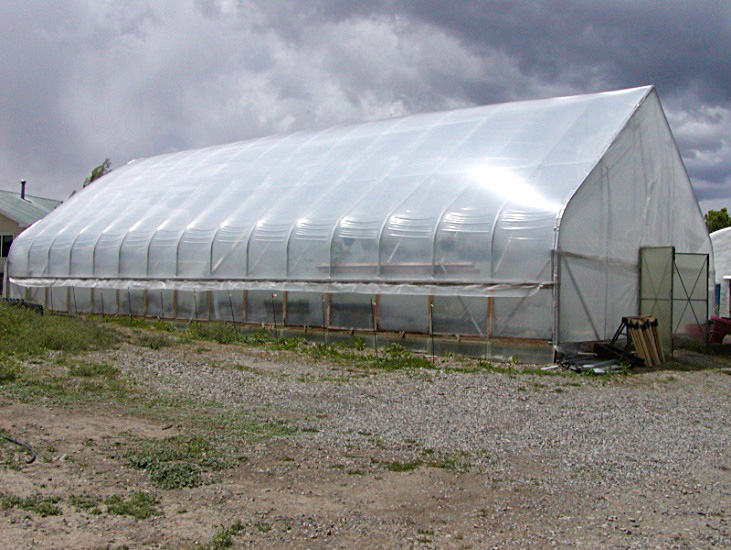 I have one unheated 30 x 60 foot greenhouse that was used to test the solar-modular grow beds. Back in 2003, the greenhouse was only used 9 weeks out of the year for overflow bedding plants. With the addition of the solar-modular grow beds; I can put this greenhouse to use all year. Almost all other greenhouse operations in Colorado have unheated houses that are empty for 10 months out of the year. This project could benefit most all greenhouse growers in Colorado by helping them utilize the greenhouse space and earn a profit on the otherwise unused space. This heating method is also great for setting bedding plant flats on the beds for bottom heat.
I have one unheated 30 x 60 foot greenhouse that was used to test the solar-modular grow beds. Back in 2003, the greenhouse was only used 9 weeks out of the year for overflow bedding plants. With the addition of the solar-modular grow beds; I can put this greenhouse to use all year. Almost all other greenhouse operations in Colorado have unheated houses that are empty for 10 months out of the year. This project could benefit most all greenhouse growers in Colorado by helping them utilize the greenhouse space and earn a profit on the otherwise unused space. This heating method is also great for setting bedding plant flats on the beds for bottom heat.
I created 18 solar-modular grow beds in my 30 x 60 ft. greenhouse. Each solar-modular grow bed was constructed out of cinder blocks and is 4.5 feet wide by 13 feet long by 2 feet high. Inside the bottom of the unit is weed barrier and half inch thick blue board insulation for a thermal break from the ground. Next, a four inch perforated pipe was installed in the bottom of the bed to introduce the warm air flow. Then the bed was filled with 3/4 inch screened gravel. Also, vent pipes were installed in the corners to let the cold air out. The gravel is the heat storage for the bed. A layer of plastic was placed on top of the gravel to keep the water and soil out of the gravel.
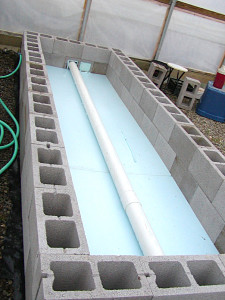
Bottom of grow bed
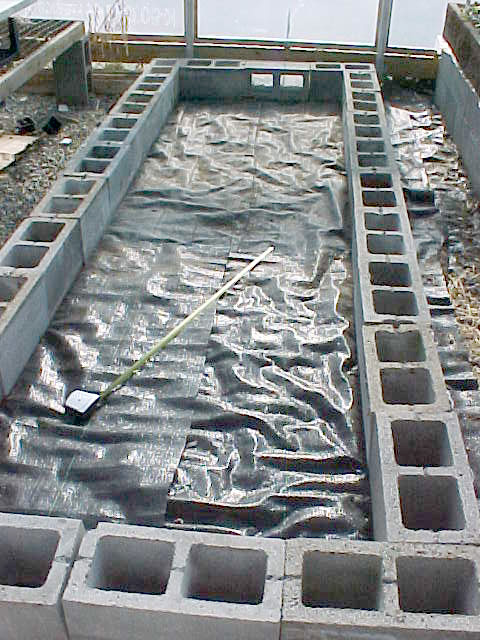
Screened gravel
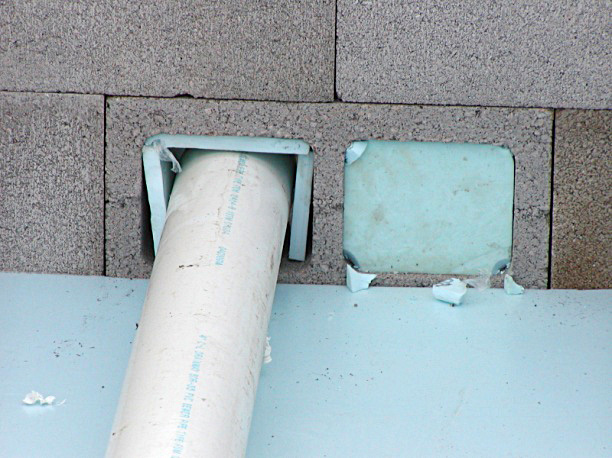
Vent pipe
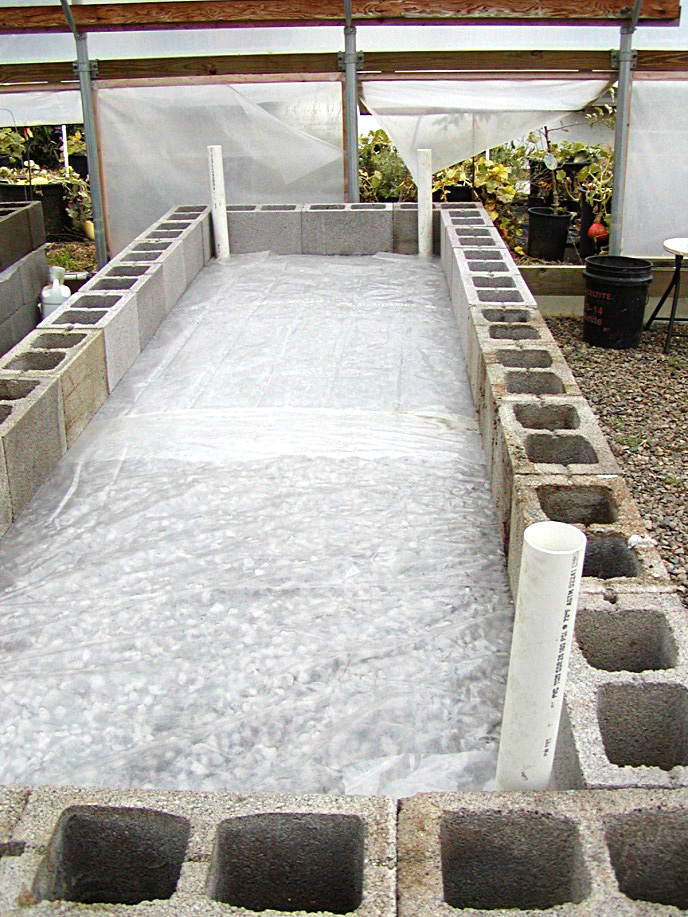
Plastic layer
A small squirrel cage fan pulls the hot air from the ceiling down a long tube into two beds.
There is a screen placed on the end of the tube to keep the birds and wasps out.
The growing media is placed on top of the plastic sheet for growing the plants.
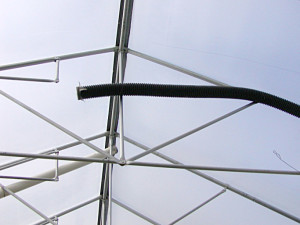
Ceiling hose
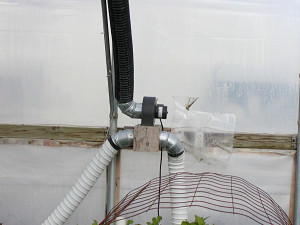
Screen at end of tube
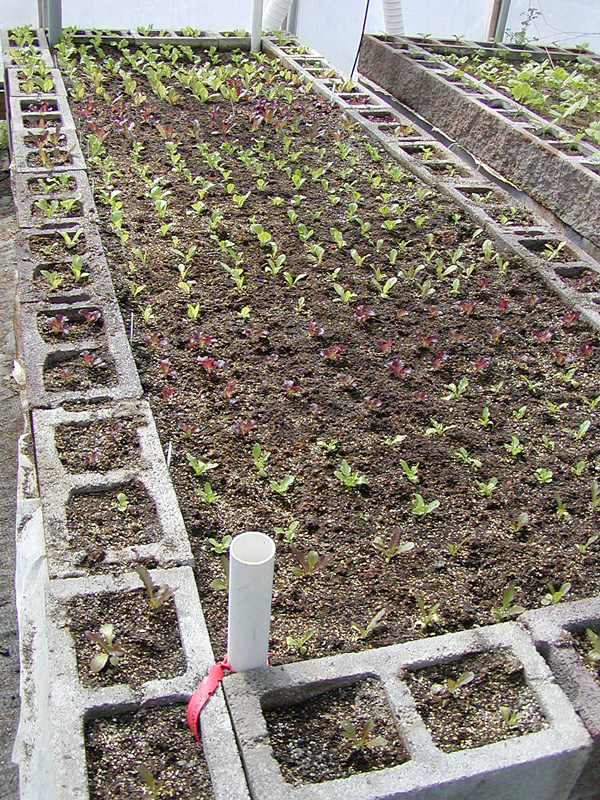
Plants on growing media
The cold frame bed cover was made of 6” x 6” concrete reinforcement wire mesh covered with frost blankets. Each bed is its own separate unit. The use of moderate sized beds will provide growers with the ability to increase the number of beds to meet production demands.
Because of the night temperatures, we had to add heavier frost blankets to keep the tops of the plants above freezing. The plants would survive a frost with the light weight covers but it made the product unsalable.
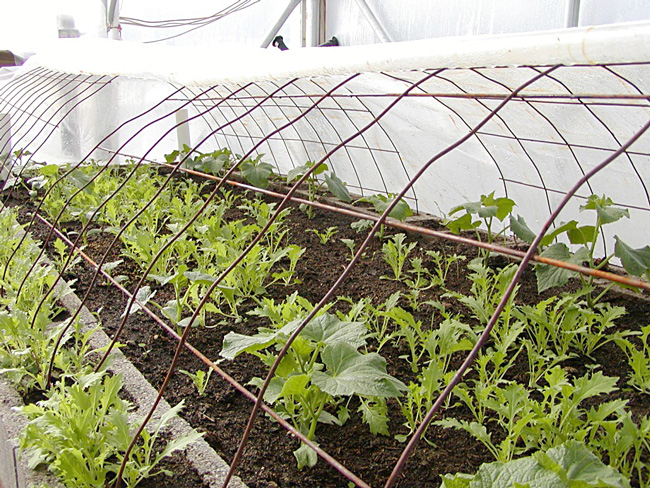
Cold frame bed cover
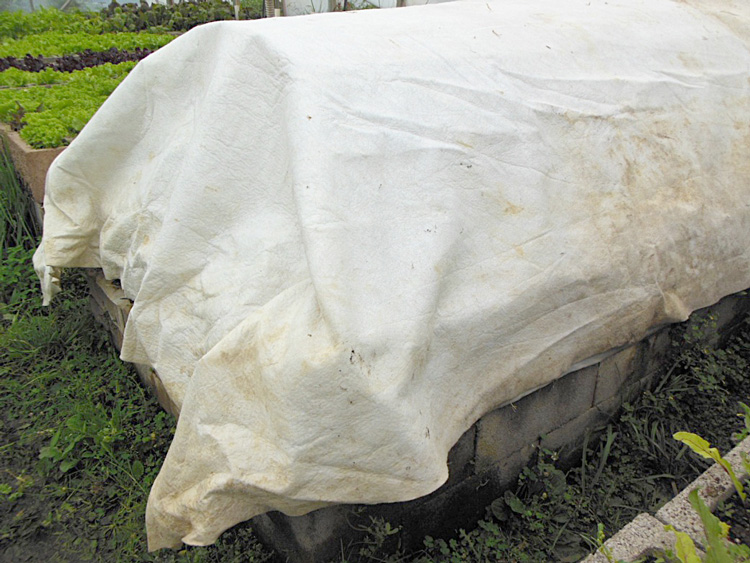
Frost blanket
Production vs Costs
Here is the breakdown of the production and heat costs results per year.
2004/05
Total greens produced in a 22 week time from October 2004 thru March 2005 was 409 pounds x $7.50 per pound = $3,067.50. The estimated propane usage was 4200 gallons. The propane costs average this winter was $1.78 per gallon. 4200 gallons x $1.78 = $7476. If we heated the greenhouse with propane we would have a profit loss of $-4408.50 not counting other business costs. The solar heating had a nominal cost of electricity to run the blowers of $154. The profit (not taking into account other business expenses) on the solar is $ 3,067.50- $154 = $2,913.50.
2005/06
Total greens produced in a 22 week time from October 2005 thru March 2006 was 409 pounds x $8.25 per pound = $3374.25. The estimated propane usage was 4200 gallons. The propane costs average this winter was $2.59 per gallon. 4200 gallons x $2.59 = $10878.00. If we heated the greenhouse with propane we would have a profit loss of $-7503.75 not counting other business costs. The solar heating had a nominal cost of electricity to run the blowers of $154. The profit (not taking into account other business expenses) on the solar is $ 3374.25- 154 = $3220.25. The difference between using propane and solar heating was a net gain of $10724.00.
2006/07
Total greens produced in a 22 week time from October 2006 thru March 2007 was 398 pounds x $8.25 per pound = $3283.50. The estimated propane usage was 4200 gallons. The propane costs average this winter was $2.94 per gallon. 4200 gallons x $2.94 = $12,348.00. If we heated the greenhouse with propane we would have a profit loss of $-9,064.50 not counting other business costs. The solar heating had a nominal cost of electricity to run the blowers of $164. The profit (not taking into account other business expenses) on the solar is $ 3283.50- $164 = $3119.00. The difference between using propane and solar heating was a net gain of $12,184. Since the start of this project the average cost of propane has risen from $1.78 per gallon to $2.94 per gallon.
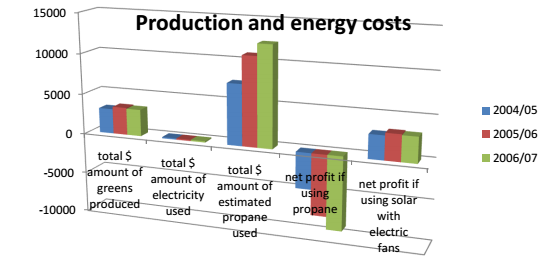
I was very shocked to find out that we would lose so much income if we heated the greenhouse in order to have a crop. It took about 30 minutes per day to cover and uncover the crops but it was well worth the effort to save thousands of dollars. The labor costs to cover and uncover would run around $610 per season.
We also tracked the temperatures around the building, in the soil, in the building and under the covers. These tests helped us to determine if the temperatures were adequate to grow a crop in the winter. I was very pleased with the results of the temperature test.
Temperature
We recorded the temperature of the soil 4 inches down in the bed, under the cold frame covers, in the greenhouse and outside the greenhouse.
The soil temperature averaged over the three years 56.5 ° Fahrenheit. The air temperature under the cold frame cover over three years averaged 53.7° F. The outside air temperature averaged 35.1 deg. F. The air temperature inside the building averaged 48.1°F. The soil temperature over the three years averaged 21.4 ° F above the outside air temperature. This is significant enough that a crop of greens can be grown in the winter.
| Year | Soil | Under covers | Outside | Inside |
|---|---|---|---|---|
| 2004/05 | 58.8 | 54.2 | 36.1 | 49.3 |
| 2005/06 | 57.1 | 53.9 | 37.3 | 48.9 |
| 2006/07 | 53.5 | 53.1 | 32.0 | 46.2 |
| Average | 56.5 | 53.7 | 35.1 | 48.1 |
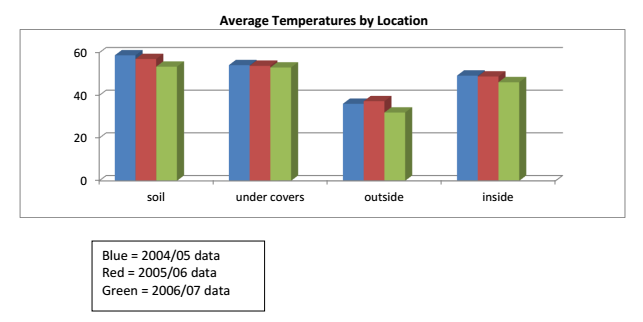
There were also other factors that went into growing a winter crop. Plants grow slowly under short days even if the soil is above 50 degrees. We averaged one pound of greens per bed per week in the winter and in the warmer summer months we average 3 pounds per bed per week. I think some of this is due to the fact that in the “summer” there is a longer day length and in the “winter” the nights are longer. This curve of production would hold true whether we used propane to heat or the solar heat.
The crops that survived and produced all winter were: Red Giant Mustard, Kyona Mustard, Kale, Collards, Hong Vit, Joi Choi, Leaf Lettuce, Summer Fest, Spinach, Yukina, and Swiss Chard.
The cold nights over the 2006/07 season really tested the system. We recorded 8 nights below zero and we had record low temperatures of -11.5 °F twice. The previous two years the lowest temperature we had was -6°F. One stretch was 5 nights in a row below zero, this test really showed that the plants could survive and keep producing. I feel that this system has proven itself to protect the plants from freezing down to -11.5 ° F.
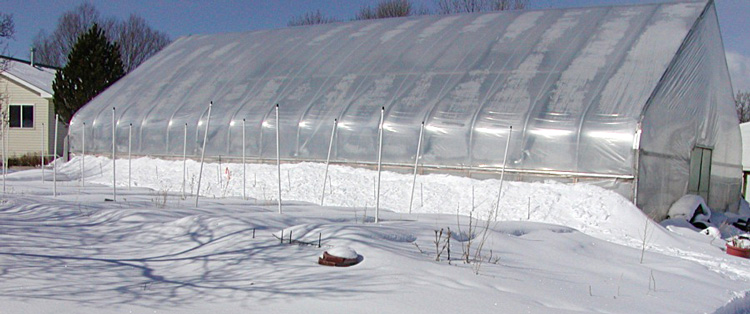 The week of January 15, 2007, was the week we recorded 5 nights below zero, the coldest night being -11.5 °F. The soil temperature held between 39-52 degrees. The week was sunny so the solar collection was increasing the soil temperature an average of 13 degrees between the morning temperatures and the evening temperatures. The coldest building temperature that week was 23.5 °F. All the plants were covered with 6 ounce heavy duty frost blanket and the plants survived with minimum leaf damage due to frost. I felt that this was a true test of the system and that the system held up to a pretty harsh test. I feel confident that I can grow greens any winter here in Paonia, CO. and the plants will survive and produce income. One great thing about the snow was that it sealed all the flaps shut in the winter so no cold air could blow under the edge of the building or through the vent flaps on the sides.
The week of January 15, 2007, was the week we recorded 5 nights below zero, the coldest night being -11.5 °F. The soil temperature held between 39-52 degrees. The week was sunny so the solar collection was increasing the soil temperature an average of 13 degrees between the morning temperatures and the evening temperatures. The coldest building temperature that week was 23.5 °F. All the plants were covered with 6 ounce heavy duty frost blanket and the plants survived with minimum leaf damage due to frost. I felt that this was a true test of the system and that the system held up to a pretty harsh test. I feel confident that I can grow greens any winter here in Paonia, CO. and the plants will survive and produce income. One great thing about the snow was that it sealed all the flaps shut in the winter so no cold air could blow under the edge of the building or through the vent flaps on the sides.
Conclusion and Discussion
The heat system
We hear a lot about our petroleum sources dwindling and how the price of gas and propane is on the rise. With these circumstances we will not see the price of propane coming down any time in the future. Just over the three years of this experiment, the price of propane in our area increase from $1.78 per gallon to $2.94 per gallon. This is an increase of over 65% in 3 years. The price of the greens increased only .75 cents per pound in a three year span.
Greens grown in a greenhouse using propane for the heat source is a losing proposition from the beginning. As the 3 years went on, this loss would be even greater.
It is important for growers to find a way to grow without using fossil fuels for heat. This experiment has clearly shown that a grower can produce a crop at a profit with using solar for heat.
The crop selection
Crop selection is critical to the success of this project. This system is for plants that can tolerate a night or two of frost. The plants that did well in this test were: Red Giant Mustard, Kyona Mustard, Kale, Collards, Hong Vit, Joi Choi, Leaf Lettuce, Summer Fest, Spinach, Yukina, Bull’s Blood Beets (greens) and Swiss Chard.
The growers skills
As with any business, the skill of the person running the operation will have an effect on the outcome. It takes a different set of growing skills to produce greens in the winter than in the summer. A few years of growing or mentoring will get the grower into a skills set necessary to grow well. Also the grower will get to know the system and know what the system is capable of handling.
The growing system
I found the beds to be plenty adequate in the soil depth and soil structure. I used compost and organic fertilizer (Happy Frog Fruit and Flower Fertilizer) to feed the plants and microbes. Winter watering was about once a week and twice a week if really sunny.
The cold frames were a must. We covered them with heavy duty frost blankets. It was really important to keep the frost blankets dry so they would insulate better during the night. On cloudy days we left the frost blankets on the plants. When the thermometer rose above 50 deg. F we uncovered the plants on the sunny days. The 6 ounce frost blankets really made the difference between having plants make it through really cold night or not making it. I purchased the roll of heavy duty frost blanket from Denver Wholesale Florist, product # 92203, 15’x 300’ 6 oz. roll $440.01 + shipping $30 = $470.01 in 2004. We still have the same frost blankets today and they are in great shape.
The building
The orientation of the building is critical to the success of the project. A north/south end wall orientation brings in more light. We have another greenhouse that runs east/west and it never got above 65 deg. F. during the day in December and January. The greenhouse we did the solar experiment in would be up around 80 deg. F. on sunny days during December and January. It was a very noticeable difference when moving from house to house. I don’t think a solar heated bed project would work in the east/west end wall house.
Final Thoughts
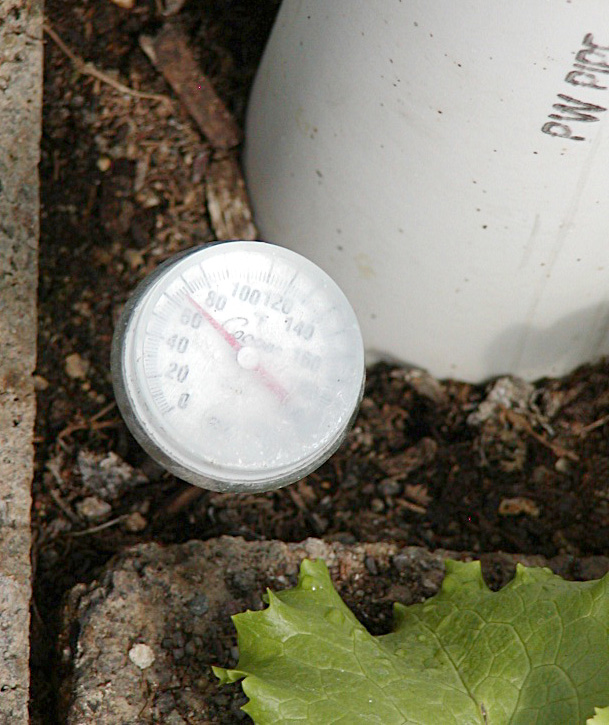 This system will work in areas where the winter temperatures don’t go below about -15 deg. F for extended periods of time. Growing in the winter will not make as much money as growing in the summer because of the shorter days and colder nights. It is possible to make a profit in the winter if you use a solar system for heating the soil. I would like to see this experiment done again in a place that has fewer sunny days to see if it would work there.
This system will work in areas where the winter temperatures don’t go below about -15 deg. F for extended periods of time. Growing in the winter will not make as much money as growing in the summer because of the shorter days and colder nights. It is possible to make a profit in the winter if you use a solar system for heating the soil. I would like to see this experiment done again in a place that has fewer sunny days to see if it would work there.
It has now been 10 years that we have grown in this system. I love the way it produces greens. We plant it every year and I can sleep at night knowing that the plants will live. Once in a while we will get a frost under the covers. What we have discovered is that if we do not touch the plants until they have thawed out, they are perfect and can be harvested. If we pick the leaves while frozen they will turn black and mushy by the end of the day.
In the spring, by mid March, I can plant green beans in the beds because the soil temperature has warmed up to around 65 deg. F consistently. Outside we can’t plant green beans until May 15. This gives us an 8 week jump on the season which means we have the first green beans to the market. I would feel confident to plant tomatoes and cucumbers mid March as well.
It feels good to me to help the planet by not burning the 4200 gallons of propane every year. That would be 42,000 gallons of propane that we have saved over the 10 years we have grown in this system and we have no plans for stopping. This system had proven its worth to the farm. Over the years we have done many tours showing people how to create a system like this for their operation.
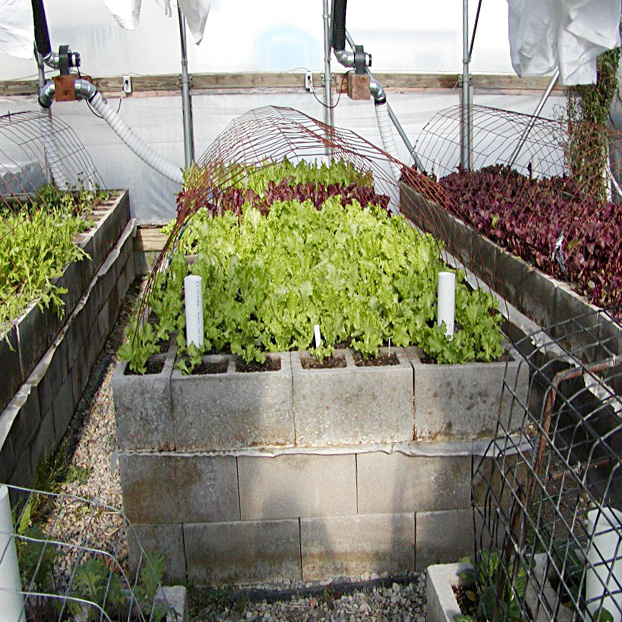
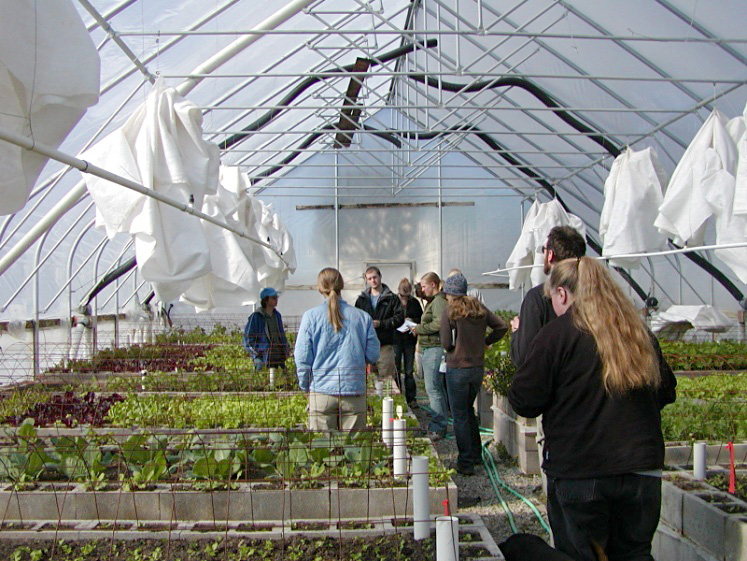
Visit our Greenhouses page to see our other structures on the farm.

